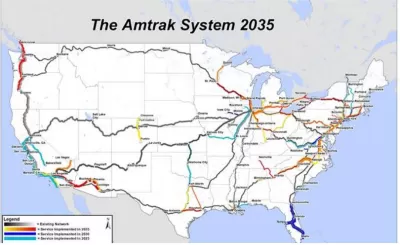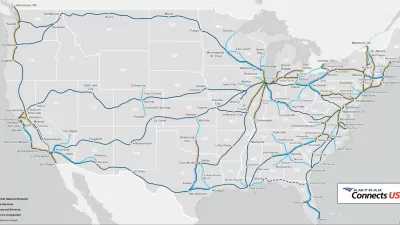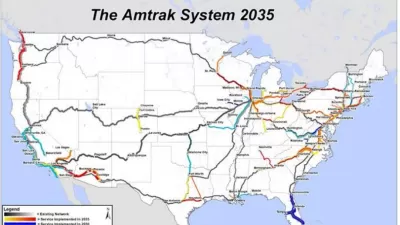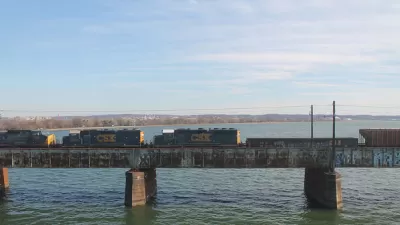Even while dealing with the economic fallout of the pandemic, Amtrak is forging forward with plans to expand intercity rail passenger service around the country.

2021 is starting on an optimistic note for Amtrak. The House Transportation and Infrastructure Committee recently approved a measure to include $1.5 billion in funding for Amtrak as part of the larger, $1.9 trillion stimulus bill still making its way through Congress.
But Amtrak also has plans for a $25 billion expansion of service that is moving forward amidst the uncertainty and contractions of the pandemic. A recent article by Eric Anderson describes the scope of Amtrak's "corridor" plan that would add intercity passenger rail service all over the country—places like Tennessee, Texas, and Nevada. An article about the five corridors proposed for Ohio was the most-read news article of the first week of February on Planetizen.
"Amtrak is focusing on developing new 'corridors,' routes tying together population centers that are several hundred miles apart and offer frequent train service. Some of the changes would be extensions of existing routes," explains Andersen of the strategic thinking of the broader expansion plan before digging into the details of the proposed corridors in New York State (Andersen is writing for the Albany Times Union) and the Capital Region.
Amtrak could extend service between Albany and Buffalo beyond to Cleveland and potentially Toledo and Detroit, for example. Service between Detroit and New York City is under consideration as well, along with restoring the corridor from New York City to Scranton, Pa., and possibly north to Binghamton.
Andersen also provides a lot of information about proposed corridor service in other parts of the country, noting that much of the program would focus on the South and West. "Completely new corridors would connect Chattanooga and Nashville with Atlanta; Atlanta and Charlotte; Jacksonville with Orlando, Tampa and Miami; Los Angeles with Las Vegas; Los Angeles with Phoenix and Tucson; and Denver with communities along the front range of the Rocky Mountains."
As for how Amtrak would achieve such a lofty ambition for passenger rail in the United States, Andersen writes: "Amtrak is proposing a five-year, $25 billion spending plan that would pay for trains and other equipment, as well as covering startup and other operating costs, with the operating support gradually shifting over a period of years to the state in which the trains are operating."
Planetizen first reported on Amtrak's expansion plans in October 2020.
FULL STORY: Amtrak route restructure targets new corridors

Trump Administration Could Effectively End Housing Voucher Program
Federal officials are eyeing major cuts to the Section 8 program that helps millions of low-income households pay rent.

Planetizen Federal Action Tracker
A weekly monitor of how Trump’s orders and actions are impacting planners and planning in America.

The 120 Year Old Tiny Home Villages That Sheltered San Francisco’s Earthquake Refugees
More than a century ago, San Francisco mobilized to house thousands of residents displaced by the 1906 earthquake. Could their strategy offer a model for the present?

HSR Reaches Key Settlement in Northern California City
The state’s high-speed rail authority reached an agreement with Millbrae, a key city on the train’s proposed route to San Francisco.

Washington State Legislature Passes Parking Reform Bill
A bill that would limit parking requirements for new developments is headed to the governor’s desk.

Missouri Law Would Ban Protections for Housing Voucher Users
A state law seeks to overturn source-of-income discrimination bans passed by several Missouri cities.
Urban Design for Planners 1: Software Tools
This six-course series explores essential urban design concepts using open source software and equips planners with the tools they need to participate fully in the urban design process.
Planning for Universal Design
Learn the tools for implementing Universal Design in planning regulations.
Ada County Highway District
Clanton & Associates, Inc.
Jessamine County Fiscal Court
Institute for Housing and Urban Development Studies (IHS)
City of Grandview
Harvard GSD Executive Education
Toledo-Lucas County Plan Commissions
Salt Lake City
NYU Wagner Graduate School of Public Service





























